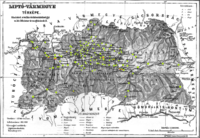Liptó County
| Liptó County Liptó vármegye (Hungarian) Comitatus Liptoviensis (Latin) Komitat Liptau (German) Liptovská župa (Slovak) | |||||
| County of the Kingdom of Hungary | |||||
| |||||
|
Coat of arms | |||||
 | |||||
| Capital | Liptószentmiklós 49°5′N 19°37′E / 49.083°N 19.617°ECoordinates: 49°5′N 19°37′E / 49.083°N 19.617°E | ||||
| History | |||||
| • | Established | 15th century | |||
| • | Treaty of Trianon | 4 June 1920 | |||
| Area | |||||
| • | 1910 | 2,246 km2 (867 sq mi) | |||
| Population | |||||
| • | 1910 | 86,900 | |||
| Density | 38.7 /km2 (100.2 /sq mi) | ||||
| Today part of | | ||||
| Liptovský Mikuláš is the current name of the capital. | |||||
Liptó County (Hungarian: Liptó vármegye, Latin: Comitatus Liptoviensis, Slovak: Liptovská župa, German: Komitat Liptau, Polish: Komitat Liptów) was an administrative county (comitatus) of the Kingdom of Hungary. Its territory is now in northern Slovakia.
Geography
Liptó county shared borders with the Austrian land Galicia and the Hungarian counties Árva, Turóc, Zólyom, Gömör-Kishont and Szepes. The county's territory was situated along the upper Vág (present-day Váh) river between the High Tatras and the Low Tatras. Its area was 2,247 km² around 1910.
Today, the territory of the former Liptó County largely corresponds to the Ružomberok District and Liptovský Mikuláš District in northern Slovakia. Three villages (Liptovská Teplička, Štrba and Štrbské Pleso) are now in the Poprad District.
Capitals
The capitals of the county were the Liptó Castle, later Németlipcse (present-day Partizánska Ľupča), and since 1677 the capital was Liptószentmiklós (present-day Liptovský Mikuláš).
History
Liptó county as a Hungarian comitatus arose before the 15th century. At various points throughout history the county was ruled by Voivodes or Counts from the Rosenberg, Csák and Benyovszky families. In the aftermath of World War I, the area became part of newly formed Czechoslovakia, as recognized by the concerned states in 1920 by the Treaty of Trianon.
Demographics
1900
In 1900, the county had a population of 82,159 people and was composed of the following linguistic communities:[1]
Total:
- Slovak: 75,938 (92.5%)
- Hungarian: 2,708 (3.3%)
- German: 2,475 (3.0%)
- Croatian: 6 (0.0%)
- Romanian: 3 (0.0%)
- Ruthenian: 2 (0.0%)
- Serbian: 2 (0.0%)
- Other or unknown: 1,025 (1.2%)
According to the census of 1900, the county was composed of the following religious communities:[2]
Total:
- Roman Catholic: 43,979 (53.5%)
- Jewish: 3,092 (3.8%)
- Calvinist: 71 (0.1%)
- Lutheran: 34,953 (42.5%)
- Greek Catholic: 49 (0.1%)
- Unitarian: 4 (0.0%)
- Greek Orthodox: 3 (0.0%)
- Other or unknown: 8 (0.0%)
1910

In 1910, the county had a population of 86,906 people and was composed of the following linguistic communities:[3]
Total:
- Slovak: 78,098 (89.9%)
- Hungarian: 4,365 (5.0%)
- German: 2,591 (3.0%)
- Romanian: 222 (0.3%)
- Ruthenian: 25 (0.0%)
- Croatian: 11 (0.0%)
- Serbian: 1 (0.0%)
- Other or unknown: 1,593 (1.8%)
According to the census of 1910, the county was composed of the following religious communities:[4]
Total:
- Roman Catholic: 47,772 (55.0%)
- Lutheran: 35,169 (40.5%)
- Jewish: 3,237 (3.7%)
- Calvinist: 289 (0.3%)
- Greek Catholic: 284 (0.3%)
- Greek Orthodox: 11 (0.0%)
- Unitarian: 3 (0.0%)
- Other or unknown: 141 (0.2%)
Subdivisions
In the early 20th century, the subdivisions of Liptó County were:
| Districts (járás) | |
|---|---|
| District | Capital |
| Liptószentmiklós | Liptószentmiklós, (today Liptovský Mikuláš) |
| Liptóújvár | Liptóújvár, (today Liptovský Hrádok) |
| Németlipcse | Németlipcse, (today Partizánska Ľupča) |
| Rózsahegy | Rózsahegy, (today Ružomberok) |
| Urban districts (rendezett tanácsú város) | |
| Rózsahegy, (today Ružomberok) | |
References
- ↑ "KlimoTheca :: Könyvtár". Kt.lib.pte.hu. Retrieved 2012-06-26.
- ↑ "KlimoTheca :: Könyvtár". Kt.lib.pte.hu. Retrieved 2012-06-26.
- ↑ "KlimoTheca :: Könyvtár". Kt.lib.pte.hu. Retrieved 2012-06-26.
- ↑ "KlimoTheca :: Könyvtár". Kt.lib.pte.hu. Retrieved 2012-06-26.

